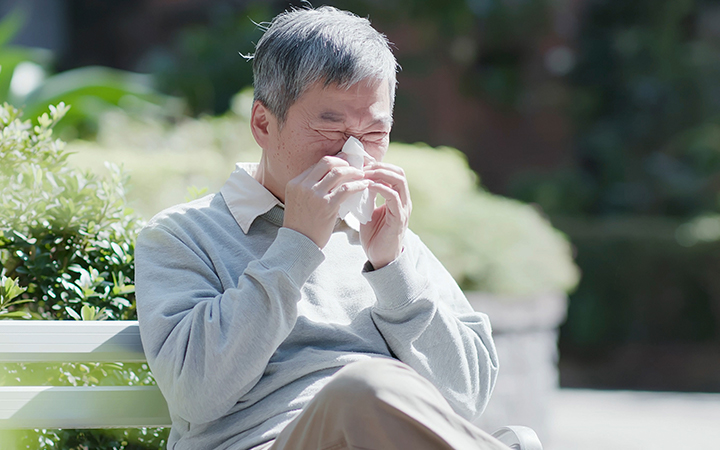Best Tips to Survive the Fall Ragweed Allergy Season
September 12, 2019

It’s that time of year again – time for drippy noses, watery eyes, congestion, coughing and sneezing due to fall seasonal allergies.
Many people think goldenrod – those thick bunches of tall, bright yellow-topped plants you see by the roadside -- is to blame. But in Northeast Ohio, ragweed is the main culprit, says Nancy Wasserbauer, DO, an allergy and immunology specialist at University Hospitals.
Ragweed blooms at the same time in the fall, but has less showy green or white buds. The plant is potent, however. Unlike goldenrod, ragweed relies on airborne pollination – its flower spews large amounts of tiny, lightweight pollen grains into the air to be taken by the wind to another plant – or your nostrils. A single ragweed plant can produce a pound of pollen grains. Ragweed also can cause skin conditions such as hives.
Ragweed’s small grains of pollen stay in the air a long time – increasing the chances of pollenating another plant – but they also stay in your body for long time as well, Dr. Wasserbauer says. Ragweed also can cause skin conditions such as hives.
Relief for fall allergy sufferers usually comes after the first frost.
Kicking Off Allergy Symptoms
What does pollen have to do with allergy symptoms? Allergies occur when your body’s immune system treats the allergen as a foreign invader. This starts a chemical reaction that produces and sends histamine throughout the blood.
“An allergy is an overactive immune system response,” Dr. Wasserbauer says.
When pollen gets inside your body, you have an immune response. The drippy sinuses, watery eyes, coughing and sneezing – all are your body’s overzealous attempt to expel the pollen, Dr. Wasserbauer says.
Allergies occur when the body’s immune system treats the allergen, in this case ragweed, as a foreign invader, Dr. Wasserbauer says. This starts a chemical reaction, which produces and sends histamine throughout the blood stream, causing allergy symptoms to develop.
When It’s Time to See an Allergist
Many people try to treat their allergy symptoms with over-the-counter medicines, and that’s fine if symptoms are mild and not interfering with daily life. But Dr. Wasserbauer says it’s worthwhile to consult an allergy specialist – even if symptoms are mild.
“The best way to prevent allergy symptoms is to know what you’re allergic to,” she says. “Once you know, the best treatment is to avoid the thing causing the allergy. Once you know, you can take steps to lessen the chance of having an allergic reaction.”
For example, you might experience allergy symptoms in the fall, but it could be due to ragweed, grasses or trees – or something else. Knowing what exactly you are allergic to can help you to avoid symptoms.
Left untreated, allergies can lead to asthma, hives, and other conditions.
“Then it becomes a long, ongoing problem with shots, immunotherapy or other therapies to change the body to non-allergenic,” Dr. Wasserbauer says. “We want to prevent the morbidities that come along with advanced allergies.”
If you decide to see an allergist, it’s important to choose a board-certified allergist, Dr. Wasserbauer says.
“Many medical conditions look like an allergy,” she says. “We want to make sure we are not missing something that mimics an allergy. If you go to someone who is trained with that, you have a better chance of getting a correct diagnosis.”
What To Expect From a Visit to an Allergy Specialist
When you visit an allergy specialist, the physician will give you a physical exam and ask you about your medical history, the timing of your symptoms and what medicines you have already tried, among other issues.
Your allergy specialist may also recommend a skin test. In a skin test, a small amount of the allergen is applied to your forearm or back. If the area feels itchy after 15 or 20 minutes, it’s a sign that you are allergic to the allergen.
Your allergist can recommend medications that may provide temporary relief from symptoms.
When allergies because a severe, life-interfering issue, an allergist can administer allergy immunotherapy in the form of shots or sublingual tablets, Dr. Wasserbauer says.
“These therapies can change the immune response to one that will tolerate the allergen and decrease the bothersome allergy symptoms,” she says.
Simple Steps to Manage Ragweed Allergy
The best way to control ragweed allergy is to avoid contact with pollen. Dr. Wasserbauer says to take these precautions:
- Keep pollen out of your house by closing the windows and using air conditioning.
- Take a shower or bath when you come inside the house from outside activities to remove pollen from your skin.
You can track regional pollen count through the National Allergy Bureau to help you decide when you should avoid spending a lot of time outdoors. Some weather websites also provide pollen counts.
RELATED LINKS
Test your knowledge about seasonal allergies with our quiz.
Need to find a doctor? Use the UH Find a Doctor tool to find a primary care physician or allergy specialist located conveniently near you.
Tags: Allergies, Primary Care


